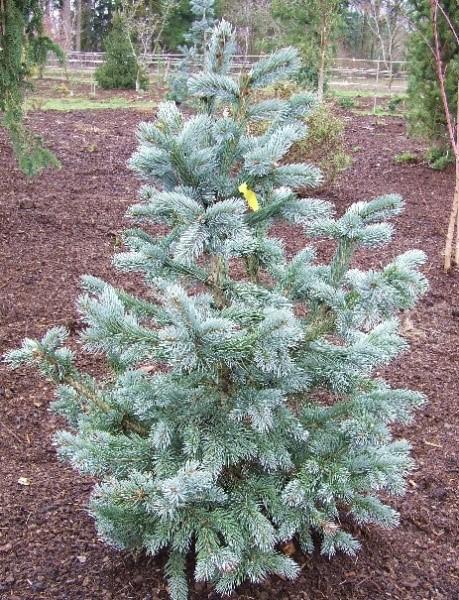Content
Ayanskaya spruce is one of the oldest inhabitants of taiga forests. Beginners often confuse it with common spruce. Unlike the latter, this tree has light needles and abundant vegetation near the trunk. In addition, it lives up to five centuries, which is much longer than other representatives.
Description of Ayan spruce with photo
The shape of the plant's crown resembles a pyramid. The needles are densely spaced, and their ends are sharp enough to injure a curious animal. The upper needles are dark green, while the lower ones have whitish stripes. Branches free from fruiting are smaller and softer.
You can distinguish young shoots from adults by their color. The first ones are distinguished by a light green tint, which later turns into blue. The buds are ovoid in shape and rich yellow in color. There is no resin inside them; on top they are covered with peculiar scales with pubescence.
The cones are cylindrical and most beautiful when ripe. At first they are green or light purple, then become brighter. They grow up to 7.5 cm. Flowering lasts for two weeks. The period usually starts in May or June.

Recently, Ayan spruce has been gaining popularity in Japan.
In deep soil, the roots grow up to 1 m, in shallow soil - only up to 25 cm.The shoots sometimes come out. Ayan spruce can grow in any soil except dry and swampy. The tree prefers shady areas with access to moisture. Grows well along rivers.
The needles contain many useful substances, thanks to which Ayan spruce has become popular in folk medicine. For example, it contains essential oils, resins, trace elements, vitamins K and E. Infusions prepared from the plant serve as an anesthetic and have a disinfecting effect.
Dimensions and height of Ayan spruce
On average, a tree grows up to 30 m, although in forests there are specimens up to 40 m and higher. The diameter of an adult spruce can be from 60 to 120 cm. The needles are not very large, only 2 cm.
Where does Ayan spruce grow?
The plant lives in the Kamchatka Territory, the southern part of Yakutia, Sakhalin, Primorye, and the Amur region. Ephedra can be found on the coastal strip of the Sea of Okhotsk.
Methods of application
Residents of the Far East consider the Ayan spruce to be the “foundation” of the forest. Wood is used in the production of paper and pulp products. Although it is inferior in technical qualities to the European variety, the culture is highly valued in the industrial sphere. It is known that trees grown on flat areas have higher wood properties than those cut down in mountainous areas.
Individual parts of the plant (cones, shoots, needles) are used in medicine. Much more often, Ayan spruce is used in landscape design. The ephedra looks great against the background of other spruce trees. In addition, the tree emits a pleasant smell during the flowering period and purifies the air.The Ayan variety is planted in parks and other public places.
Advantages and disadvantages
Ayan spruce has interesting decorative properties. Its buds change color throughout its development.

Due to rapid deforestation, the tree was listed in the Red Book
Pros:
- unpretentiousness;
- pleasant aroma;
- high content of useful substances;
- large fruits;
- winter hardiness.
Minuses:
- not suitable for growing in dry climates.
Planting and care
Gardeners recommend planting Ayan spruce in loamy soils. It is necessary to choose a shaded area, otherwise the crop will not be able to grow normally. The tree does not tolerate transplantation well, they try to perform the procedure as rarely as possible.
The soil must be drained. It is advisable to dig up the area and lay out a layer of stones 15 cm deep. The optimal size of the planting hole is 50x70 cm. The seedling must be covered for the winter. Watering is carried out 2-3 times a week.
The soil should not be allowed to dry out. In the first year after planting, watering is carried out regularly. A seedling needs 10 liters of liquid. In the future, watering can be reduced slightly, moistening the soil as it dries out.

Male inflorescences can be eaten for medicinal purposes
To allow the roots to access oxygen after watering, the area is loosened. It is important not to go too deep so as not to damage the root shoots. Mulch should be added after heavy rain. This will allow moisture to linger without requiring the gardener to water again.
Ayan spruce needs feeding and removal of deformed, disease-affected branches. The cut areas are treated with ash and covered with varnish to prevent fungus.
Reproduction methods
Ayan spruce is propagated by seeds. Moist loamy soils are suitable for the latter. In such conditions there is a greater chance of getting seedlings. Planting material is demanding regarding air pollution. Landing in urban areas is difficult.
Ayan spruce lends itself well to propagation in forest parks, rural areas, and in the country. With proper care, the tree can be grown in any climate.
Diseases and pests
The plant can be harmed by:
- spider mite;
- spruce budworm;
- aphid;
- sawfly.
During the growth process, Ayan spruce may develop Schutte, rust or cancer.
Photos in landscape design

Ayan spruce looks great against the background of stones

Ephedra has several subspecies, differing in the structure of the cones.

Even young seedlings form incredibly beautiful cones

The Ayan variety is planted away from roads, otherwise the plant may die
Conclusion
Ayanskaya spruce is an ornamental plant growing in the eastern part of Russia. It spread across several large regions, managing to become a favorite garden tree of different peoples. Spruce needles contain many useful substances, which is why they are used in alternative medicine. The bark is used in paper production.








